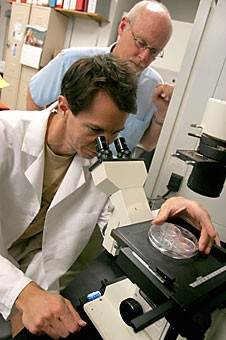From the world’s first human cornea transplant to the growth of a pancreas, researchers at the UA are using stem cells to make medical breakthroughs, despite the controversy surrounding stem cell research.
Rather than fighting governmental restrictions on embryonic stem cell experimentation, UA scientists avoided the taboo research altogether by working primarily with stem cells found in umbilical cord blood, said David T. Harris, a professor of microbiology and immunology.
Although researchers from Advanced Cell Technology, a biotechnology company in California, said they recently discovered a way to extract stem cells from embryos without harming the potential fetus, the discovery won’t change the way university labs conduct research.
“”It’s a great political debate, but it has become neither side providing important information to the public,”” said Harris.
Within one year, Harris said UA labs expect to successfully perform the world’s first human cornea transplant from stem cells found in umbilical cord blood.
In addition, nerve and heart tissue regeneration in animals, specifically mice, have proven highly successful in these labs, Harris said.
Harris said stem cells found in umbilical cord blood appear to be the equivalent of stem cells found in embryos.
However, Jonathan Flax, an assistant professor of neurology, said the difference between adult stem cells and embryonic is highly debatable.
Flax said as a general rule, embryonic stem cells have the capability to differentiate into any cell, such as a germ cell, T-cell or those found in organs, but adult stem cells have not been proven to differentiate in the same manner.
“”Maybe we don’t see it because it’s such a rare cell, but we haven’t seen the appropriate cues (for unlimited differentiation),”” said Flax, who studies the mechanisms that restrict potential stem cells’ lineages using neural stem cells.
Still, researchers are making progress with umbilical cord stem cells.
The congestive heart failure lab at the University Medical Center, which uses stem cells in umbilical cord blood, hopes to become the first to carry out a successful regeneration of heart tissue in a human suffering from heart disease, said Elise Furfaro, a graduate student in pathobiology who is a lab manager and research specialist.
Michael Badowski, a graduate student in microbiology and immunology and research specialist, said his lab is starting a project where cartilage tissue is grown from stem cells using umbilical cord blood.
Badowski said tissue rejection is a major problem for organ transplants today, and through this type of research, stem cells can be isolated and made into any cell desired because of their vital role in tissue repair.
Experiments with mouse stem cells are being used to grow new pancreases, a potential breakthrough for those suffering from diabetes.
“”Why do I have to give you my kidney if you can grow your own?”” Badowski said.
Harris is the lab director of Cord Blood Registry, the world’s first and largest cord blood bank, which is located in Tucson and started in UA labs.
Furfaro said cord blood is collected from mothers who sign a release, and the blood is stored in the bank, ready to treat children if necessary.
Cord blood is especially valuable in regenerative medicine, spinal cord or brain injury or if the family has a history of cancer, Harris said.
“”Many people don’t know that you have to use your own stem cells for it to work,”” said Harris.
Extracting cord blood at birth can be vital for an individual who develops a disorder like cerebral palsy, aplastic anemia or various forms of leukemia.
Whether or not President Bush accepts this new method of embryonic stem cell research, UA labs intend to continue their research with umbilical cord blood.
“”It’s very exciting, but this change isn’t going to really affect us,”” Furfaro said. “”We are going to keep working with our project using the alternative (umbilical cord blood).””









